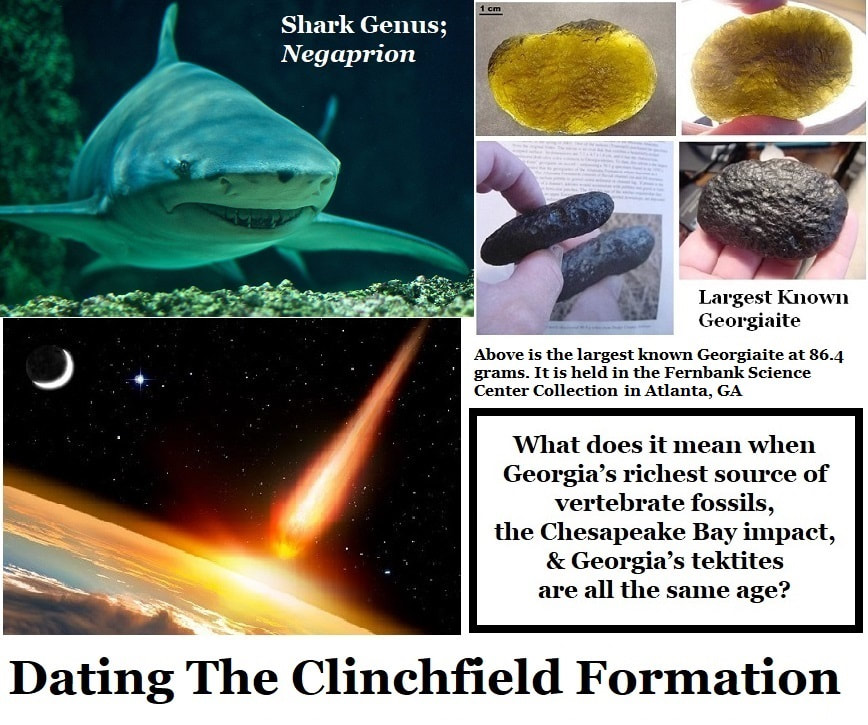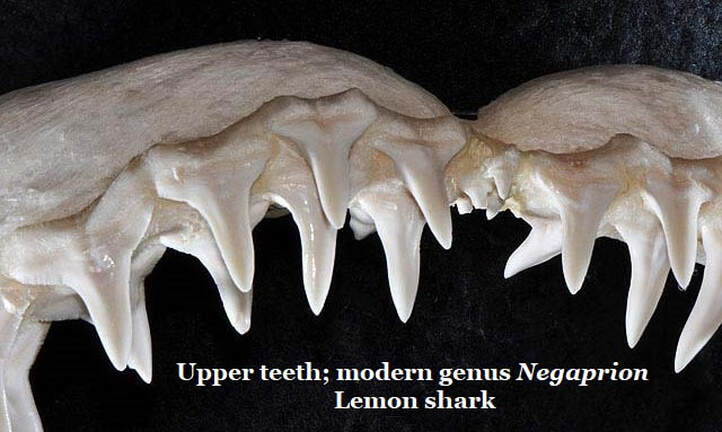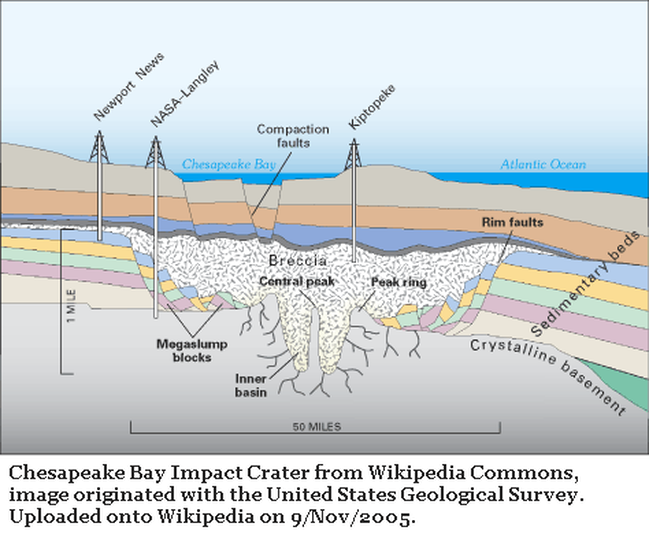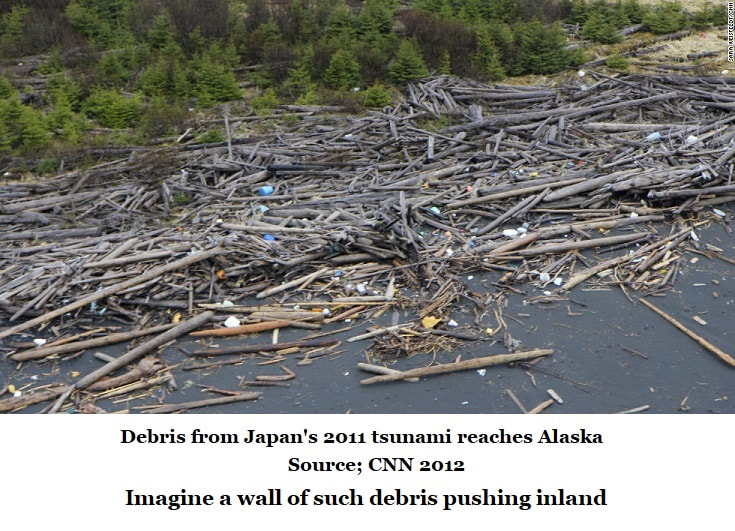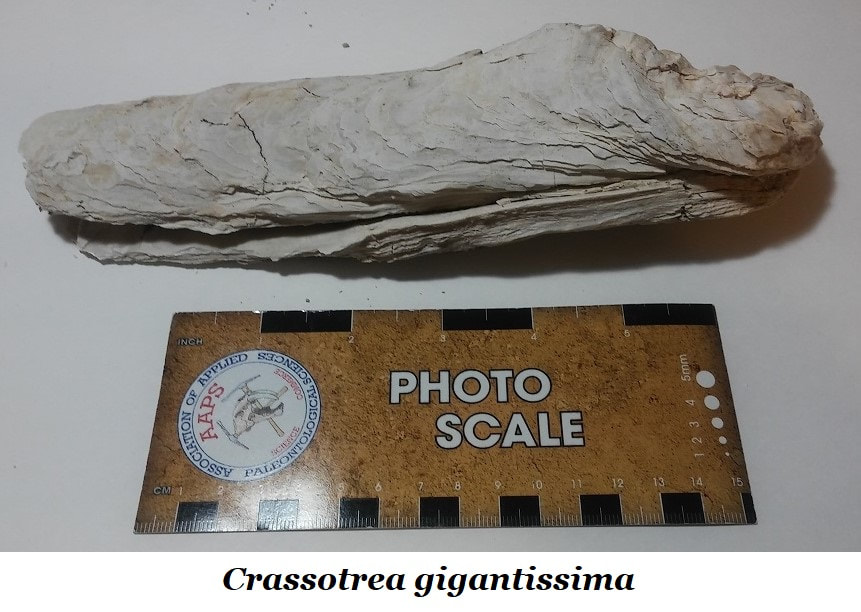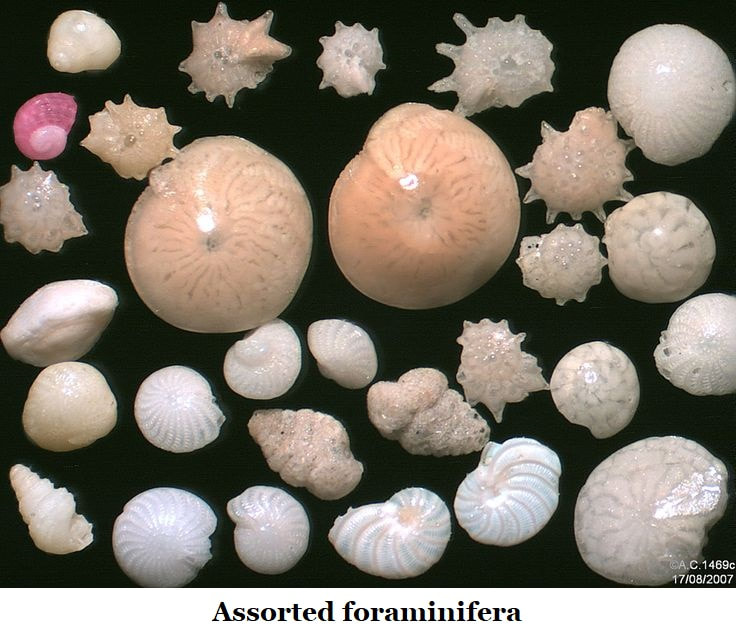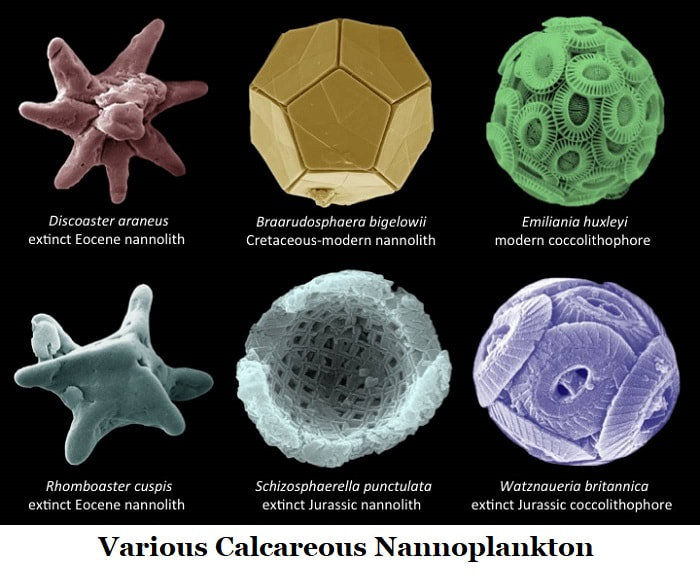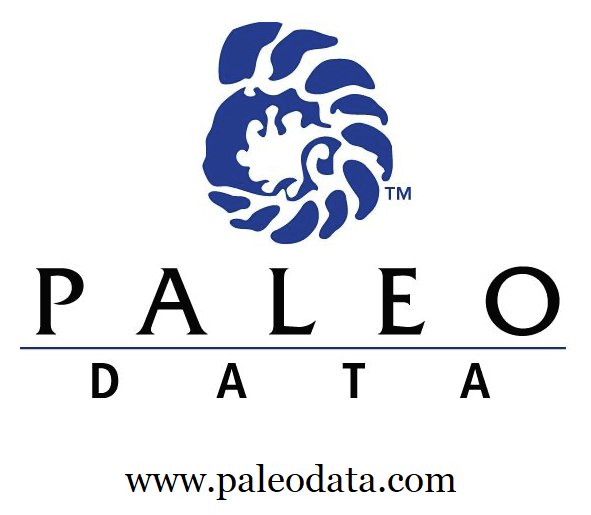14B
Fossils, Impacts & Tektites
Dating the
Clinchfield Formation
By Thomas Thurman
Filed /11/Jan/2020
Georgia’s Clinchfield Formation has produced more than 9,700 scientifically reported vertebrate fossils scattered among about 50+ species of sharks, bony fish, reptiles, marine mammals, terrestrial mammals & one bird. These were reported from either Houston County or Wilkinson County. Such a wealth of material makes the Clinchfield our state’s richest source of vertebrate material.
As if that wasn’t enough; four separate researchers, using 4 different processes, at three different times, reached the same conclusion about the age of the Clinchfield Formation. It possibly dates to the same timeframe as Georgia’s tektites and the Chesapeake Bay Impact event.
The Clinchfield Formation was laid down about 35.5 million years ago with an error rate of plus or minus roughly half a million years.
The Georgia State fossil is the shark tooth.
James W. Westgate reported 1,538 lemon shark teeth, species; Negaprion gibbesi in 2001 (1,Pg.279) during his research in Wilkinson County’s Hardie Mine.
In 2003 Dennis Parmley at Georgia College in Milledgeville reported 2,127 teeth from another extinct lemon shark Negaprion eurybathrodon recovered from the same mine. (2,Pg.173)
Brand new in 2020 is a report of two new species of sharks reported by David J. Cicimurri, Jun A. Ebersole & George Martin. Cicimurri is with the South Carolina State Museum. Ebersole is with the McWane Science Center in Alabama & Martin is an independent researcher, like myself, out of Alabama. They discovered and named the species, Mennerotodus parmleyi, in honor of Dennis Parmley (see above) and the species Mennerotodus mackayi. (14, Abstract)
James W. Westgate reported 1,538 lemon shark teeth, species; Negaprion gibbesi in 2001 (1,Pg.279) during his research in Wilkinson County’s Hardie Mine.
In 2003 Dennis Parmley at Georgia College in Milledgeville reported 2,127 teeth from another extinct lemon shark Negaprion eurybathrodon recovered from the same mine. (2,Pg.173)
Brand new in 2020 is a report of two new species of sharks reported by David J. Cicimurri, Jun A. Ebersole & George Martin. Cicimurri is with the South Carolina State Museum. Ebersole is with the McWane Science Center in Alabama & Martin is an independent researcher, like myself, out of Alabama. They discovered and named the species, Mennerotodus parmleyi, in honor of Dennis Parmley (see above) and the species Mennerotodus mackayi. (14, Abstract)
Questions persist about the age of the Clinchfield Formation. Recent papers have placed it between 36.o–34.2 million years old. But research dating back to 1972 (3,Pg.E9), repeated in 2001 (4) and refined in 2017 (5) show that the Clinchfield Formation is roughly 35.5 million years old, allowing for an error rate of 300,000 years.
The oldest fossils reported from the Clinchfield went extinct 35.42 million years ago (5), allowing for a margin of error, the formation cannot be older than its oldest fossils.
The Chesapeake Bay Impact Event, which is the source of Georgia tektites or Georgiaites, (6) probably occurred at the top of the Clinchfield Formation, the United States Geologic Survey (USGS) dates the impact to 35.5 million years ago.
The Chesapeake Bay Impact Event, which is the source of Georgia tektites or Georgiaites, (6) probably occurred at the top of the Clinchfield Formation, the United States Geologic Survey (USGS) dates the impact to 35.5 million years ago.
To recap;
- The USGS places the Chesapeake Bay Impact at 35.5 (+or-.3) million years ago. (6)
- In 1996 Edward Albin dated several georgiaites to 35.2 (+or-.3) million years old (7).
- A foraminifera fossil reported in the Clinchfield in 1972 went extinct at 35.42 million years ago which establishes a maximum age for the formation. (3&5)
- A foraminifera collected from the Chesapeake Bay crater & by the USGS went extinct at 36.18 million years ago. (15)
- All of these dates have an error rate of 300,000 years plus or minus.
The Impact Event
The USGS reports that a bolide fell from space and smacked violently into the shallow sea off Virginia’s Coast (4). The explosion was terrific, vaporizing the bolide and essentially forming Chesapeake Bay. This event was unknown by science until the crater was accidentally discovered beneath the sediments of the bay in 1983, the event was scientifically described and dated in 1993.
To paraphrase Wikipedia’s entry on The Chesapeake Bay Impact Crater; the initial impact excavated a feature about 40 km (25 miles) wide and fractured basement rock to a depth of 8km (5 miles). In a handful of seconds millions of tons of water, sediments, and shattered rock were cast beyond the atmosphere and space, only to later fall along the East Coast. In the aftermath; “An enormous megatsunami engulfed the land and possibly even reached the Blue Ridge Mountains.” (6) The original crater walls have since collapsed to create the current feature at 85km (53 miles) wide.
To paraphrase Wikipedia’s entry on The Chesapeake Bay Impact Crater; the initial impact excavated a feature about 40 km (25 miles) wide and fractured basement rock to a depth of 8km (5 miles). In a handful of seconds millions of tons of water, sediments, and shattered rock were cast beyond the atmosphere and space, only to later fall along the East Coast. In the aftermath; “An enormous megatsunami engulfed the land and possibly even reached the Blue Ridge Mountains.” (6) The original crater walls have since collapsed to create the current feature at 85km (53 miles) wide.
Imagine the possible series of events…
The impact blasted away at least a 40 km circle of shallow sea water.
The impact blasted away at least a 40 km circle of shallow sea water.
- The initial crater was roughly half a mile deep.
- The explosion vaporizes a great mass of water and seabed, creating a shockwave which radiated outward.
- A megatsunami rises pushing even more water from the impact site. The tsunami raced outward, and down the East Coast.
- Coastlines quickly & temporarily recede as water is pulled into the giant wave.
- The tsunami strikes Georgia coastline washing plants and any nearby animals into a debris front leading the tsunami and inundating the hills and forests.
- As the water drains back no doubt injured and dead animals were carried into the sea.
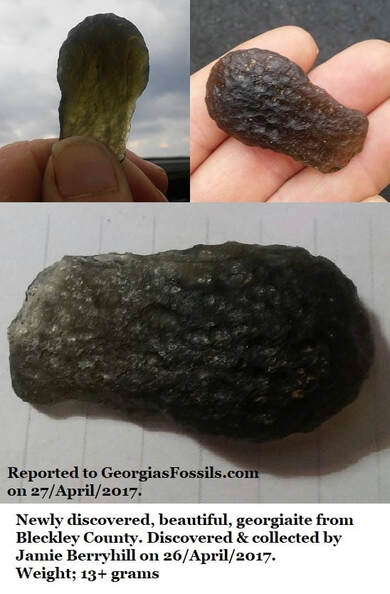
Flight of the georgiaites
There’s a great deal we don’t know about georgiaites, like how long it took them to fly the 1045 km (650 miles) ballistic flight path from the Virginia impact site to say Bleckley County, GA. However, think about it in these terms, in 1961 Alan Shepard became America’s first astronaut with a suborbital, ballistic flight in a Mercury capsule. His flight reached an altitude of 201 km (125 miles) and a range of 351 km (218 miles), and it lasted 15 minutes and 28 seconds. Georgia’s tektites had to fly more than three times the distance than Shepard’s flight.
(For more on Georgiaites see section 14J of this website.)
The acknowledged expert on georgiaites, Hal Povenmire, once told me in a field conversation that he’d expect the natural dispersion of tektites falling across Georgia to be maybe 1 or 2 tektites per acre on that fateful day. Sadly, Hal left us recently, passing in early December 2019.
While certainly cataclysmic for North America’s East Coast, the Chesapeake Bay Impact was not a global event and probably only had minimal impact on the Northern Hemisphere as a whole, at 35.5 million years ago the Earth was still warm, sea levels were high, and our poles were likely ice free. The hot-house Eocene would endure for another 1.65 million years. Finally, a global glacial event and extinction occured when the hot-house Eocene ended and the cooler Oligocene opened, but that would be at 33.9 million years. Research in 2008 and 2009 by Kenneth G. Miller and Amiee E. Pusz at Rutgers University clearly showed that the global glaciation which initiated the Oligocene Epoch was a natural event requiring no extraterrestrial influence. (9 & 10)
Dating the Clinchfield
Sam Pickering accurately described the Clinchfield Formation in 1970 from its occurrence in Houston County as a medium-grained, well sorted, poorly consolidated quartz sand. “The sand is massive and no bedding or cross-bedding may be observed… The Clinchfield Sand grades upward into the, Tivola Limestone, through a zone of sandy limestone lenses and sand beds approximately five feet thick. In this report the top of the Clinchfield Sand is placed at the highest bed of unconsolidated sand. The author (Pickering) has observed the Clinchfield Formation in outcrop as far from the study area as Rich Hill, in Crawford County, and Irwinton, in Wilkinson County, Georgia. Wherever seen, lithology and top and bottom criteria have been consistent; therefore, formational status…is here suggested.”
Sam Pickering accurately described the Clinchfield Formation in 1970 from its occurrence in Houston County as a medium-grained, well sorted, poorly consolidated quartz sand. “The sand is massive and no bedding or cross-bedding may be observed… The Clinchfield Sand grades upward into the, Tivola Limestone, through a zone of sandy limestone lenses and sand beds approximately five feet thick. In this report the top of the Clinchfield Sand is placed at the highest bed of unconsolidated sand. The author (Pickering) has observed the Clinchfield Formation in outcrop as far from the study area as Rich Hill, in Crawford County, and Irwinton, in Wilkinson County, Georgia. Wherever seen, lithology and top and bottom criteria have been consistent; therefore, formational status…is here suggested.”
As mentioned earlier the oldest reported fossil from the Clinchfield Formation is a 35.42 million-year-old microscopic foraminifer species from inside a large Crassostrea gigantissima oyster. In 1966 Pickering observed that the Clinchfield was limier near its upper contact with the overlying Tivola. He reported “Reef-like accumulations of articulated oysters in their growth positions” he continued by observing “These beds are characterized by their extensive large oyster assemblages, indicating a shallow water environment.” (11,pg.30) Pickering reported these beds at about half-a-meter (1.5 to 2 ft) beneath the Tivola Limestone. (3,pg.E3) He collected research samples of the articulated oysters.
(For more on Crassostrea gigantissama see Section 14K of this website.)
(For more on Crassostrea gigantissama see Section 14K of this website.)
Pickering gave the oysters to Stephen M. Herrick, a biostratigrapher with the USGS, who published his research in 1972 and included a list of 50+ microscopic foraminifera fossils he’d removed from inside a single oyster. (3,Pg.E8) It would seem these oysters were closed when the tsunami hit, trapping and preserving their accumulated forams. Not all were so lucky, Pickering reported that many were “scattered at random through the sediments with little orientation of the separated valves” and “fossil fragments in the sand are likewise broken and abraded.” (11,Pg.30)
Microscopic foraminifera (forams) and nannoplankton fossils are the backbone of dating sediments. The emergence, endurance and extinction of the host of foraminifera and nannoplankton species which has occurred over the last 160+ million years has been carefully studied and documented in research funded primarily by oil exploration. The oil companies are intensely interested in the age of sediments. As early as 1965 the first charts were published for dating foraminifera species. In 1970 similar works were published on nannofossils. This work has continued creating an ever-finer tool for oil companies to date sediments. Essentially, if you collect and identify species from any location and identify foosils with known emergence or extinction dates, you can get an accurate age. Foraminifera and nannoplankton continue to be the preferred fossils for dating sediments.
In 1986 Paul Huddlestun (13) reported that the Clinchfield ranged from 9 to 35 feet thick west of the Ocmulgee River, the western-most exposures is at Rich Hill in Crawford County were about 10 to 12 feet of the Clinchfield can be seen beneath the Tivola Limestone; it is reportedly rich in shark’s teeth. Exposures to the east of the river are if similar thickness; at Little Keg Creek in Washington County there is an exposure about 1.5 to 4.0 feet thick.
Previous to Pickering’s research the sand beneath the Tivola Limestone was considered to be significantly older, maybe Middle Eocene. Pickering doubted that. Because of observed Periarchus sand dollars fossils he suspected it was Jacksonian. The Jacksonian series is held to run roughly from 33.9 to 36.8 million years ago and is part of the Late Eocene’s Priabonian Stage, recent researchers like Huddlestun have broken the Jacksonian into an early and late phase. The long, warm Eocene Epoch ended at 33.9 million years ago.
Previous to Pickering’s research the sand beneath the Tivola Limestone was considered to be significantly older, maybe Middle Eocene. Pickering doubted that. Because of observed Periarchus sand dollars fossils he suspected it was Jacksonian. The Jacksonian series is held to run roughly from 33.9 to 36.8 million years ago and is part of the Late Eocene’s Priabonian Stage, recent researchers like Huddlestun have broken the Jacksonian into an early and late phase. The long, warm Eocene Epoch ended at 33.9 million years ago.
Herrick opened his oyster. We should keep in mind that the Crassostrea genus of oysters are true oysters. Many members of the genus Crassostrea are still around and some are important food sources for humans. They can often be found in the intertidal zone, being submerged at high tide and exposed at high tide. With that in mind Herrick reported; “…since the microfossils at Clinchfield were obtained from a thick-shelled oyster occurring in a fossil reef, they must have been deposited in extremely shallow water in the zone between low and high tides or even in the zone of wave action itself.” (3,Pg.E12)
Herrick reported that he’d identified 50+ species of foraminifera from inside that Crassostrea gigantissima. (See list after references.) He took that information and performed extensive fieldwork collecting additional samples from older sediments in Baldock, South Carolina and additional known Jacksonian sediments at Claiborne Bluff in Alabama and the Moodys Branch Formation in Jackson, Mississippi; which is where the Jacksonian name was coined.
After careful lab work identifying and correlating a host of species from all three additional locations, Herrick found that the Clinchfield Formation held more fossil in common with the Jacksonian sediments than the slightly older material from Baldock, South Carolina. Herrick confidently concluded that the Clinchfield Formation was indeed Jacksonian. Field observations by Pickering supported Herrick’s research and in 1972 the two men, following different paths of research, were in agreement; the Clinchfield was Jacksonian.
All that from the contents of a single articulated oyster.
After careful lab work identifying and correlating a host of species from all three additional locations, Herrick found that the Clinchfield Formation held more fossil in common with the Jacksonian sediments than the slightly older material from Baldock, South Carolina. Herrick confidently concluded that the Clinchfield Formation was indeed Jacksonian. Field observations by Pickering supported Herrick’s research and in 1972 the two men, following different paths of research, were in agreement; the Clinchfield was Jacksonian.
All that from the contents of a single articulated oyster.
Modern Technology;
Today, Paleo-Data.com, “a full-service micropaleontological consulting firm” is currently the leader in dating foraminifer and nannoplankton for the oil exploration industry in Gulf Basin species. They publish detailed, free access pdf charts of species extending back 160 million years (5).
Paleodata; https://www.paleodata.com/chart
Herrick identified the species Textularia dibollensis in the Clinchfield Formation of Houston County. Paleodata’s Paleogene Biostratigraphic Chart of the Gulf Basin, sets its extinction date at 35.42 million years (Foram Zone NP19-20) , a maximum age for the sediments. That’s modern, high tech research confirming field work and lab work from 1972.
Bearing Herrick's work in mind; Paog, Koeberl, & Reimold, in their research on Chesapeake Bay reported the foram species Globigerinatheka semiinvoluta occurring whose extinction Paleodata places at 36.18 million years (Foram Zone, NP19-20).
This tells us that the impact event and the Clinchfield Formation both occupy Foram Zone NP19-20, which according to Paleodata, spans; 34.45 to 37 million years ago.
Today, Paleo-Data.com, “a full-service micropaleontological consulting firm” is currently the leader in dating foraminifer and nannoplankton for the oil exploration industry in Gulf Basin species. They publish detailed, free access pdf charts of species extending back 160 million years (5).
Paleodata; https://www.paleodata.com/chart
Herrick identified the species Textularia dibollensis in the Clinchfield Formation of Houston County. Paleodata’s Paleogene Biostratigraphic Chart of the Gulf Basin, sets its extinction date at 35.42 million years (Foram Zone NP19-20) , a maximum age for the sediments. That’s modern, high tech research confirming field work and lab work from 1972.
Bearing Herrick's work in mind; Paog, Koeberl, & Reimold, in their research on Chesapeake Bay reported the foram species Globigerinatheka semiinvoluta occurring whose extinction Paleodata places at 36.18 million years (Foram Zone, NP19-20).
This tells us that the impact event and the Clinchfield Formation both occupy Foram Zone NP19-20, which according to Paleodata, spans; 34.45 to 37 million years ago.
*
If further proof was needed; a 30/December/2019 email from Dr. Lucy Edwards, a highly respect biostratigrapher reads; (4)
“Hi Thomas, I have not thought about the Hardie Mine in years. Along about 2001, Rob Weems gave me a sample from Dennis Parmley (Footnote A). A year or so later, I called its attention to Scott Harris (Footnote B) as being the right age for the Chesapeake Bay impact and having dinocysts that were broken and with wall-structure damage. Here's what Scott and colleagues published.”
Scott Harris stood as lead author on a 2004 paper entitled; Upper Eocene Impact Horizon in East-Central Georgia, published by the Geological Society of America. (12)
“Hi Thomas, I have not thought about the Hardie Mine in years. Along about 2001, Rob Weems gave me a sample from Dennis Parmley (Footnote A). A year or so later, I called its attention to Scott Harris (Footnote B) as being the right age for the Chesapeake Bay impact and having dinocysts that were broken and with wall-structure damage. Here's what Scott and colleagues published.”
Scott Harris stood as lead author on a 2004 paper entitled; Upper Eocene Impact Horizon in East-Central Georgia, published by the Geological Society of America. (12)
This sample from Hardie Mine not only gives us another reviewer confirming the age of the sediments but also confirms that they two outcrops are the same formation.
In Houston County the Twiggs Clay and Clinchfield Formation is separated by 12 meters (40ft) of the Tivola Limestone which is the focus of the mining efforts in Cemex of Houston County.
To the east, The Tivola Limestone is frequently missing having weathered out before the Twiggs Clay was deposited. The Tivola is generally a softish limestone. In one Twiggs County mine the Tivola is only 3 meters (10ft) thick. In Wilkinson County’s Hardie Mine near Gordon, Georgia the Tivola Limestone is absent, and the Twiggs Clay and Clinchfield Formation are in direct contact as an unconformity. The Tivola is also absent in Jefferson County’s Purvis Mine where Harris did some of his research.
In Houston County the Twiggs Clay and Clinchfield Formation is separated by 12 meters (40ft) of the Tivola Limestone which is the focus of the mining efforts in Cemex of Houston County.
To the east, The Tivola Limestone is frequently missing having weathered out before the Twiggs Clay was deposited. The Tivola is generally a softish limestone. In one Twiggs County mine the Tivola is only 3 meters (10ft) thick. In Wilkinson County’s Hardie Mine near Gordon, Georgia the Tivola Limestone is absent, and the Twiggs Clay and Clinchfield Formation are in direct contact as an unconformity. The Tivola is also absent in Jefferson County’s Purvis Mine where Harris did some of his research.
This absence or presence of the Tivola Limestone suggests that a period of time passed where the coastal Clinchfield Formation was the uppermost exposed sediments. Perhaps this was a period where sea levels had retreated. As mentioned, the Clinchfield is coastal, the oysters suggest intertidal.
The Tivola Limestone is considered more offshore and represents a high energy, current driven deposit. This possible retreat and advance in sea levels would not, necessarily, be impact related. Although perhaps a few hundred years passed where the Clinchfield was exposed before sea levels ramped back up to establish the current which would build the Tivola.
The Tivola Limestone is considered more offshore and represents a high energy, current driven deposit. This possible retreat and advance in sea levels would not, necessarily, be impact related. Although perhaps a few hundred years passed where the Clinchfield was exposed before sea levels ramped back up to establish the current which would build the Tivola.
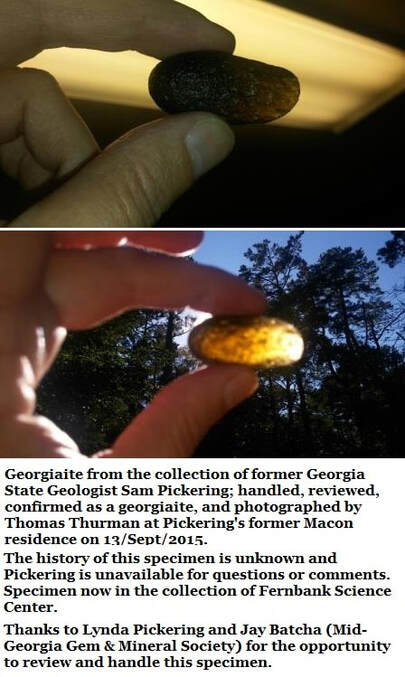
So, while the Twiggs Clay and Clinchfield Formation are both Jacksonian, even Early Jacksonian there is a gap between their deposited sequence. It is interesting to note that while the Twiggs Clay, a member of the Dry Branch Formation, is moderately to highly variable in its lithology (appearance and content), the Clinchfield Formation is not. As seen in the previous text Pickering specifically commented on this. “…Wherever seen, lithology and top and bottom criteria have been consistent...” (11,Pg.8)
It should be said here that neither Pickering nor Herrick new anything about the Chesapeake Bay Impact Event or Crater, but Pickering, at least, was aware of Georgia’s tektites. The first georgiaite was found by Dewey Horne in 1938 near the town of Empire, Georgia in Bleckley County. Pickering possessed a tektite he identified as a georgiaite.
It should be said here that neither Pickering nor Herrick new anything about the Chesapeake Bay Impact Event or Crater, but Pickering, at least, was aware of Georgia’s tektites. The first georgiaite was found by Dewey Horne in 1938 near the town of Empire, Georgia in Bleckley County. Pickering possessed a tektite he identified as a georgiaite.
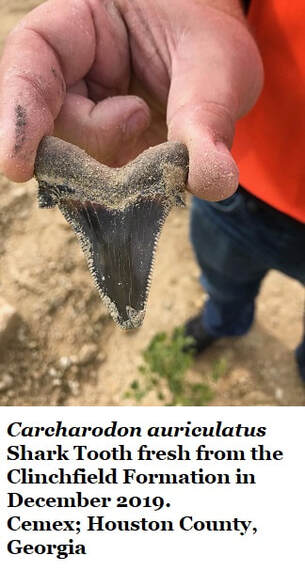
Clinchfield Formation Vertebrates
Hardie Mine, near Gordon, Georgia in Wilkinson County and the old quarries at Cemex in Houston County’s Clinchfield, Georgia are the two principal localities where the vertebrate material has been reported from the Clinchfield Formation. Shark teeth have additionally been reported several times from Rich Hill in Crawford County but I’m not aware of any systematic species identification research from Rich Hill.
Pickering was impressed by the quantity of vertebrate material observed in the late 1960s and reported; “Shark, stingray, porpoise, and sawfish teeth, along with whale and manatee bones are abundant in the Clinchfield at localities 9 and 10.” Location 9 in a reclaimed mine 3 km (1.86 miles) east-northeast of the bridge where Hwy 341 crosses over the railroad line at the Clinchfield limestone plant. Location 10 is now part of the current limestone plant, 600 meters (2,000ft) east-northeast of the same 341 highway bridge.
Westgate’s 2001 observations of the Clinchfield Formation in Wilkinson County’s Hardie Mine; “The Hardie Mine local fauna consist of a diverse near-shore marine community predominated by chondrichthyans (shark family), with a few species of reptiles, cetaceans (whales) and osteichthyans (bony fish). The coarse, well sorted sands, crocodilian bone fragments and a land mammal tooth fragment, indicate that the shoreline was close by...”
Hardie Mine, near Gordon, Georgia in Wilkinson County and the old quarries at Cemex in Houston County’s Clinchfield, Georgia are the two principal localities where the vertebrate material has been reported from the Clinchfield Formation. Shark teeth have additionally been reported several times from Rich Hill in Crawford County but I’m not aware of any systematic species identification research from Rich Hill.
Pickering was impressed by the quantity of vertebrate material observed in the late 1960s and reported; “Shark, stingray, porpoise, and sawfish teeth, along with whale and manatee bones are abundant in the Clinchfield at localities 9 and 10.” Location 9 in a reclaimed mine 3 km (1.86 miles) east-northeast of the bridge where Hwy 341 crosses over the railroad line at the Clinchfield limestone plant. Location 10 is now part of the current limestone plant, 600 meters (2,000ft) east-northeast of the same 341 highway bridge.
Westgate’s 2001 observations of the Clinchfield Formation in Wilkinson County’s Hardie Mine; “The Hardie Mine local fauna consist of a diverse near-shore marine community predominated by chondrichthyans (shark family), with a few species of reptiles, cetaceans (whales) and osteichthyans (bony fish). The coarse, well sorted sands, crocodilian bone fragments and a land mammal tooth fragment, indicate that the shoreline was close by...”
Known Vertebrate Species
Pickering’s finds are marked by (*) signifying Houston County specimens. All other come from Hardie Mine in Wilkinson County.
Genus &/or Species Common name Frequency Reporting
Fish (sharks)
Abdounia enniskilleni Extinct Gray Shark 492 teeth Westgate
Abdounia enniskilleni Extinct Gray Shark 589 Teeth Parmley
Carcharias acutissima Sand Tiger Shark 446 Teeth Parmley
Carcharias cuspidate Great White Shark Abundant Pickering*
Carcharias hopei Sand Tiger Shark 296 Teeth Parmley
Carcharias hopei Sand Tiger shark 922 teeth Westgate
Carcharias koerti Sand Tiger Shark 123 teeth Parmley
Carcharocles angustidens Megatooth Shark 2 Teeth Parmley
Carcharodon auriculatus Giant toothed shark 2 teeth Westgate
Dasyatis (sp) Stingray 53 teeth Westgate
Edaphodon (sp) 1st SE Chimaera Extremely Rare Parmley
Galeo latidens Tiger shark 219 teeth Westgate
Galeocerdo alabamensis Requiem Shark 351 Teeth Parmley
Galecerdo latidens Tiger Shark Abundant Pickering*
Ginglymostoma serra Nurse shark 13 teeth Westgate
Hemipristis curvatus Snaggletooth shark 170 teeth Westgate
Hemipristis curvatus Snaggletooth Shark 635 Teeth Parmley
Heterodontus (sp) Angel Shark 1 Tooth Parmley
Isurus (sp) Mako shark 4 teeth Westgate
Isurus praecursor Mako Shark 27 Teeth Parmley
Lamna (sp) Porbeagle shark 124 teeth Westgate
Lamna Appendiculate Mackerel shark Common Pickering*
Mustelus vanderhoefti Smoothhound Shark 3 Teeth Parmley
Myliobatis (sp) Eagle Ray Abundant Pickering*
Myliobatis (sp) Eagle ray 8 dental batteries/284 teeth Westgate
Nebrius thielensis Nurse Shark 79 Teeth Parmley
Negaprion eurybathrodon Lemon Shark 2127 Teeth Parmley
Negaprion gibbesi Lemon shark 1538 teeth Westgate
Palaeorhincodon Whale Shark 1 tooth Parmley
Physogaleus (sp) Carchrhinid 19 teeth Westgate
Physogaleus secundus Sharpnosed Shark 70 Teeth Parmley
Pristis (sp) Sawfish Very rare Pickering*
Propristis schweinfurthi Sawfish 238 rostral teeth Westgate
Raja (sp) Skate 4 skutes Westgate
Rhinoptera (sp) Cownose ray 67 teeth Westgate
Scyliorhinus gilberti Catshark 53 Teeth Parmley
Sphyrna (sp) Hammerhead Rare Pickering*
Squatina (sp) Angel shark 1 tooth Westgate
Squatina prima Angel Shark 6 Teeth Parmley
Striatolamia macrota Sand Shark 1 Tooth Parmley
Bony Fish
Phyllodus (sp) Bony fish 1 dental battery Westgate
Lepisosteus (sp) Gar 33 teeth Westgate
Sphyraena (sp) Barracuda 335 teeth Westgate
Trichiuris (sp) Cutlassfish 27 teeth Westgate
Teleost Bony fish 242 otoliths Westgate
Mammals
Basilosaurus (sp) Great Whale Rare Pickering*
Basilosaurus cetoides First great whale 18 vertebral frags Westgate
Brontotheriid Titanothere (Rhino-like) Very Rare Parmley
Brontotheriid Titanothere (Rhino-like) 1 tooth frag. Westgate
Brontotheriid Titanothere (Rhino-like) Tooth frag (2019) Rhinehart
Durodon serratus Whale (Orca sized) 4 teeth/1 cervical Westgate
(Reassigned from Zygorhiza)
Durodon Whale (Orca sized) Rare Pickering*
(Reassigned from Zygorhiza)
Daphoenus (sp) Bear-dog Very rare (2019) Rhinehart
Eosiren (sp) Manatee Common Pickering*
Hyracodon (sp) Hornless rhino Very rare (2019) Rhinehart
Megacerops (sp) Rhino-like animal Very rare (2019) Rhinehart
Palaeolagus temnodon Rabbit or hare Very rare (2019) Rhinehart
Reptiles
Family: Cheloniidae Sea Turtles Rare Parmley
Family: Trionychinae Soft Shelled Turtles Rare Parmley
Crocodylid Crocodile 25 teeth & 10 bone frags Westgate
Dermochelydidae (sp) Leather Back Turtles Rare Parmley
Nebraskophis (sp) Colubrid Snake Very Rare Parmley
Palaeophis (sp) Palaeophid Snake Rare Parmley
Palaeophis africanus Constrictor Snake Very Rare Parmley
Pterosphenus (sp) Pterosphenus Snake Very Rare Parmley
Pterosphenus schucherti Constrictor Snake Very Rare Parmley
Pterosphenus schucherti Giant aquatic snake 14 vertebrae Westgate
Trionyx (sp) Softshell turtle 17 shell frags Westgate
Avian (Bird)
Family; Alcidae Auk (Oldest N. American) Part. Humerus Chandler
Pickering’s finds are marked by (*) signifying Houston County specimens. All other come from Hardie Mine in Wilkinson County.
Genus &/or Species Common name Frequency Reporting
Fish (sharks)
Abdounia enniskilleni Extinct Gray Shark 492 teeth Westgate
Abdounia enniskilleni Extinct Gray Shark 589 Teeth Parmley
Carcharias acutissima Sand Tiger Shark 446 Teeth Parmley
Carcharias cuspidate Great White Shark Abundant Pickering*
Carcharias hopei Sand Tiger Shark 296 Teeth Parmley
Carcharias hopei Sand Tiger shark 922 teeth Westgate
Carcharias koerti Sand Tiger Shark 123 teeth Parmley
Carcharocles angustidens Megatooth Shark 2 Teeth Parmley
Carcharodon auriculatus Giant toothed shark 2 teeth Westgate
Dasyatis (sp) Stingray 53 teeth Westgate
Edaphodon (sp) 1st SE Chimaera Extremely Rare Parmley
Galeo latidens Tiger shark 219 teeth Westgate
Galeocerdo alabamensis Requiem Shark 351 Teeth Parmley
Galecerdo latidens Tiger Shark Abundant Pickering*
Ginglymostoma serra Nurse shark 13 teeth Westgate
Hemipristis curvatus Snaggletooth shark 170 teeth Westgate
Hemipristis curvatus Snaggletooth Shark 635 Teeth Parmley
Heterodontus (sp) Angel Shark 1 Tooth Parmley
Isurus (sp) Mako shark 4 teeth Westgate
Isurus praecursor Mako Shark 27 Teeth Parmley
Lamna (sp) Porbeagle shark 124 teeth Westgate
Lamna Appendiculate Mackerel shark Common Pickering*
Mustelus vanderhoefti Smoothhound Shark 3 Teeth Parmley
Myliobatis (sp) Eagle Ray Abundant Pickering*
Myliobatis (sp) Eagle ray 8 dental batteries/284 teeth Westgate
Nebrius thielensis Nurse Shark 79 Teeth Parmley
Negaprion eurybathrodon Lemon Shark 2127 Teeth Parmley
Negaprion gibbesi Lemon shark 1538 teeth Westgate
Palaeorhincodon Whale Shark 1 tooth Parmley
Physogaleus (sp) Carchrhinid 19 teeth Westgate
Physogaleus secundus Sharpnosed Shark 70 Teeth Parmley
Pristis (sp) Sawfish Very rare Pickering*
Propristis schweinfurthi Sawfish 238 rostral teeth Westgate
Raja (sp) Skate 4 skutes Westgate
Rhinoptera (sp) Cownose ray 67 teeth Westgate
Scyliorhinus gilberti Catshark 53 Teeth Parmley
Sphyrna (sp) Hammerhead Rare Pickering*
Squatina (sp) Angel shark 1 tooth Westgate
Squatina prima Angel Shark 6 Teeth Parmley
Striatolamia macrota Sand Shark 1 Tooth Parmley
Bony Fish
Phyllodus (sp) Bony fish 1 dental battery Westgate
Lepisosteus (sp) Gar 33 teeth Westgate
Sphyraena (sp) Barracuda 335 teeth Westgate
Trichiuris (sp) Cutlassfish 27 teeth Westgate
Teleost Bony fish 242 otoliths Westgate
Mammals
Basilosaurus (sp) Great Whale Rare Pickering*
Basilosaurus cetoides First great whale 18 vertebral frags Westgate
Brontotheriid Titanothere (Rhino-like) Very Rare Parmley
Brontotheriid Titanothere (Rhino-like) 1 tooth frag. Westgate
Brontotheriid Titanothere (Rhino-like) Tooth frag (2019) Rhinehart
Durodon serratus Whale (Orca sized) 4 teeth/1 cervical Westgate
(Reassigned from Zygorhiza)
Durodon Whale (Orca sized) Rare Pickering*
(Reassigned from Zygorhiza)
Daphoenus (sp) Bear-dog Very rare (2019) Rhinehart
Eosiren (sp) Manatee Common Pickering*
Hyracodon (sp) Hornless rhino Very rare (2019) Rhinehart
Megacerops (sp) Rhino-like animal Very rare (2019) Rhinehart
Palaeolagus temnodon Rabbit or hare Very rare (2019) Rhinehart
Reptiles
Family: Cheloniidae Sea Turtles Rare Parmley
Family: Trionychinae Soft Shelled Turtles Rare Parmley
Crocodylid Crocodile 25 teeth & 10 bone frags Westgate
Dermochelydidae (sp) Leather Back Turtles Rare Parmley
Nebraskophis (sp) Colubrid Snake Very Rare Parmley
Palaeophis (sp) Palaeophid Snake Rare Parmley
Palaeophis africanus Constrictor Snake Very Rare Parmley
Pterosphenus (sp) Pterosphenus Snake Very Rare Parmley
Pterosphenus schucherti Constrictor Snake Very Rare Parmley
Pterosphenus schucherti Giant aquatic snake 14 vertebrae Westgate
Trionyx (sp) Softshell turtle 17 shell frags Westgate
Avian (Bird)
Family; Alcidae Auk (Oldest N. American) Part. Humerus Chandler
Foraminifera species Stephen M. Herrick identified from inside the Crassotrea gigantissima Sam M. Pickering collected from the Clinchfield Formation in Houston County
Genus & Species Locations* PaleoData Age
Spiroplectammina mississippiensis CBAM * *
Spiroplectammina alabamensis CBAM * *
Textularia adalta CBM * *
Textularia cuyleri CB * *
Textularia dibollensis CBM Extinct 35.42
Textularia dibollensis humblei CB * *
Textularia hannai CB * *
Textularia ocalana C * *
Textularia subhavrii CB * *
Robulus alatolimbatus CBM * *
Robulus fragaria CBM * *
Planularia georgiana CB * *
Guttulina spicaeformis CBAM * *
Globulina ampulla CBA * *
Globulina gibba globosa CA * *
Globulina gibba rotundata CBA * *
Globulina minuta CM * *
Pseudopolymorphina decora CM * *
Sigmomorphina jacksonensis CBAM * *
Nonion advena CBAM * *
Nonion inexcavatus CBAM * *
Nonion planatus CBAM * *
Nonionella hantkeni spissa CBAM * *
Nonionella jacksonensis compressa CBAM * *
Elphidium texanum C * *
Buliminella laevis C * *
Bolivina jacksonensis CBAM * *
Bolivina ouachitaensis CB * *
Reussella eocena CBAM * *
Spirillina vivipara CB * *
Patellina advena CB * *
Discorbis alveata CBAM * *
Discorbis alveata stavensis CB * *
Discorbis assulata CBAM * *
Discorbis globulospinosa CAM * *
Lamarckina jacksonensis CB * *
Valvulineria jacksonensis CB * *
Gyroidina nassauensis C * *
Eponides campester CB * *
Eponides cocoaensis CB * *
Siphonina advena eocenica CBA * *
Amphistegina alabamaensis CB * *
Cassidulina moodysensis CBM * *
Turborotalia cocoaensis CB Extinct 34.03
Formerly Globorotalia cocoaensis
Anomalina danvillensis C * *
Planulina cocoaensis CB * *
Cibicides lobatulus CBAM * *
Cibicides planoconvexus CBAM * *
Cibicides pseudoungerianus CB Extinct 30.40
Cibicidina americana antiqua CAM * *
Cibicidina americana jacksonensis CBA * *
Cibicidina danvillensis CB * *
Cibicidina mississippiensis CBA * *
Cibicidina ocalana CB * *
Gypsina globula CB * *
Locations as;
C=Clinchfield, GA
B=Baldock, S.C.
A=Clairborne Bluff, Ala
M=Jackson, MS
Footnotes;
- Dr. Dennis Parmley is a retired researcher from Georgia College in Milledgeville who’s done a great deal of work on Clinchfield Formation vertebrates from Hardie Mine in Wilkinson County.
- Scott Harris is a researcher/instructor, a planetary geologist at Fernbank Science Center in Atlanta, GA who is well published on both meteorites and tektites.
References
- Westgate, James W; Paleoecology and biostratigraphy of marginal marine Gulf Coast Eocene vertebrate localities, Gunnell, G.F., eds., Eocene biodiversity, unusual occurrences and rarely sampled habitats: New York, Kluwer Academic/Plenum, p. 263–297., 2001
- Parmley, Dennis and Cicimurri, David J.; Late Eocene Sharks of the Hardie Mine Local Fauna of Wilkinson County, Georgia; Georgia Journal of Science, Vol 61: (3) pgs153-179, 2003
- Herrick, S. M.; Age and Correlation of the Clinchfield Sand in Georgia. Contributions to Stratigraphy, Geological Survey Bulletin 1354-E, USGS 1972
- Edwards, Lucy; Personal Communication; Email from 30/December/2019; “Hi Thomas, I have not thought about the Hardie Mine in years. Along about 2001, Rob Weems gave me a sample from Dennis Parmely. A year or so later, I called its attention to Scott Harris (as being the right age for the Chesapeake Bay impact and having dinocysts that were broken and with wall-structure damage). Here's what Scott and colleagues published. (See Reference)
- Paleo-Data; PDI Paleogene Biostratigraphic Chart – Gulf Basin, USA. Updated March 2o17; https://www.paleodata.com/chart/
- Koeberl, C., Poag, C. W; Reimold, W. U.; & Brandt, D.; Impact Origin of the Chesapeake Bay Structure and the Source of the North American Tektites; Vol. 271, Issue 5253, pp. 1263-1266, Science, 01 Mar 1996
- Albin, E.F. & Wampler, J.M.; New Potassium Argon Dates for and the Upper Eocene Dry Branch Formation (Twiggs Clay Member): Inferences About Tektite Stratigraphic occurrence; 27th Annual Lunar and Planetary Science Conference 1996
- Harris, R. Scott, Upper Eocene Impact Statigraphy of the Georgia Coastal Plain, Georgia Geological Society Guidebook, Volume 29, pages 25-34, 2009
- Kenneth G. Miller, James V. Browning, Marie-Pierre Aubry, Bridget S. Wade, Miriam E. Katz, Andrew A. Kulpecz & James D. Wright.; Eocene-Oligocene global climate and sea level changes: St. Stephens Quarry, Alabama. Geological Society of America Bulletin, January/February 2008.
- Aimee E. Pusz, Kenneth G. Miller, James D. Wright, Miriam E. Katz, Benjamin S. Cramer, Dennis V. Kent. Stable Isotopic Response to Late Eocene Extraterrestrial Impacts. Geological Society of America, Special Paper 452, 2009
- Pickering, Sam M.; Stratigraphy, Paleontology, and Economic Geology of Portions of Perry and Cochran Quadrangles. The Geological Survey of Georgia, Department of Mines, Mining and Geology, Bulletin 81. 1970.
- Harris Scott R., Roden Michael F., Schroeder Paul A., Holland Steven M., Duncan Mack S., Albin Edward F., Upper Eocene Impact Horizon in East-Central Georgia, Geology; August 2004; v. 32; no. 8; p. 717–720
- Huddlestun, Paul F., & Hetrick, John H. Upper Eocene Stratigraphy of Central and Eastern Georgia, Georgia Department of Natural Resources, Environmental Protection Division, Bulletin 95. 1986.
- Cicimurri, David J., Ebersole, Jun A., and Martin, George; Two new species of Mennerotodus Zhelezko, 1994 (Chondrichthyes: Lamniformes: Odontaspididae), from the Paleogene of the southeastern United States, Fossil Record; Foss. Rec., 23, 117–140, 2020, Published: 22 July 2020
- Poag, C. Wylie, Koeberl, Christian, & Reimold, Wolf Uwe; The Chesapeake Bay Crater, Geology and Geophysics of a Late Eocene Submarine Impact Structure, Section 8; Age of the Chesapeake Bay Impact Structure, Springer Press, 2004
